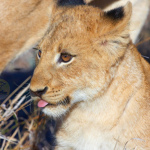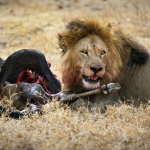The Elusive Jackson’s Three Horned Chameleon: A Wonder of Uganda’s Biodiversity.
The Three Horned Chameleon in Uganda; Scientifically referred to as Trioceros jacksonii, the Jackson’s Three-Horned Chameleon is an intriguing reptile that mainly inhabits the dense forests and montane areas of East Africa, including Uganda; it is also famous for its peculiar looks and interesting habits; due to this reason, the species has gained much importance amongst wild lovers as well as researchers.
Physical Characteristics of the Three Horned Chameleon.
The Jackson’s Three-Horned Chameleon is distinctive in most of its features. It possesses three horn-like protrusions on its head, creating the easily recognizable profile. Both males and females have these horns for species recognition and as part of the mating ritual; the males, however, have larger and more projecting horns.
They come in different colors, from bright greens and blues to earthly browns and oranges; this color adaptability helps them camouflage well among the foliages-a means of self-defense against predators and helpful in hunting.
Habitat and Distribution in Uganda.
Mainly in Uganda, you will find the Three-Horned Chameleon inhabiting the montane forests of the Rwenzori Mountains, Bwindi Impenetrable Forest, and Mgahinga Gorilla National Park. These areas provide perfect conditions that range from temperate to warm conditions with great deals of vegetation; hence, these chameleons exist.
Behavior and Diet.
These chameleons are mainly arboreal, nearly always in branches and among leaves. This unique characteristic is due to their independently moving eyes, which allow exceptionally good 360-degree vision for proper perception of prey and monitoring the environment for threats.
The diet of Three-Horned Chameleons includes insects, mainly crickets and grasshoppers, along with other small invertebrates. Its tongue can shoot out fast to capture its prey through great eyesight, targeting the food with precision.
Reproduction and Lifecycle.
Breeding behaviors of Jackson’s Three-Horned Chameleons exhibit extensive displays by males in attempts to attract females. Males are sometimes territorial, displaying bright colors in ritualistic motions designed to introduce this lizard to others as a possible mate.
Males take no part in incubation; females lay clutches of eggs in any hidden, secluded places on the floor, or under the litter of the leaves. The incubation period for such eggs is variable but generally takes several months before the young hatch and start their independent life.
Conservation Status and Threats.
Although chameleon families are not on the endangered list, their populations are threatened by habitat destruction due to deforestation and agricultural expansion, as well as intrusion by humans. Another threat to their populations includes the illegal trade in wildlife, since people sometimes capture them for selling as exotic pets.
Conservation Efforts.
Especially in Uganda, various conservation bodies like the Uganda Wildlife Authority are deeply engaged in protecting the areas these chameleons dwell in. This they do through the preservation of habitats, sensitizing the communities for the conservation of chameleons, and installing rules that deter people from illegal wildlife trade.
Conclusion on the Three Horned Chameleon.
The Jackson’s Three-Horned Chameleon is an amazing creature in Uganda’s forests. It has an amazingly interesting look and a number of curious behaviors. Any conservation should be aimed at protecting the habitat and needs of this animal to live comfortably in its natural habitat.












